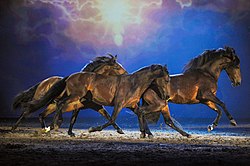Old Real
| Old Real | |
|---|---|

Alter Real stallions |
|
| Important data | |
| Origin: | Portugal |
| Main breeding area: | Portugal |
| Distribution: | Portugal |
| Stick measure : | 152-162 cm |
| Colors : | mainly brown but also fox and gray. |
| Main application area: | high school |
The Altér Real is a Portuguese horse breed that was founded by the Bragança dynasty . Portuguese hippologists also describe the Altér Real as a special line within the Lusitano breed.
Background information on horse evaluation and breeding can be found under: Exterior , interior and horse breeding .
Exterior
The Altér Real is a noble horse of the Iberian type, similar to the Lusitano . The head is narrow and dry, with a straight or rimmed profile and an elegant expression. The curved neck is set high. The shoulder is often short and steep, the withers not very pronounced. The back is short, of medium width and depth, and has good bearing capacity. The croup is strong and sloping, the hindquarters well angled. The foundation has elastic pasterns, the hooves are hard.
The Altér Real differs from the related breeds Lusitano and Pura Raza Española especially in the back and in the length of the fetlock and cannon bone (metacarpal or metatarsal bones of a horse); the upper arm of the Altér Real is always shorter than the cannon bone. The chest is wider and deeper than that of the two related breeds. The movement mechanics of the Altér Real is well suited for dressage up to high school due to its raised gaits and is favored by the natural bending of the legs.
interior
The Altér Real is tough, resilient and brave. The horses are very eager to learn and intelligent, have a quick perception and a calm, balanced temperament.
Breeding history
The beginnings of this horse breed go back to the year 1748, when the Portuguese ruling house Bragança founded a stud with around 50 first-class Andalusian mares in Vila de Portel, which, however, moved to Altér do Chão in 1756. The breed owes its name to the Altér stud ("real" means "royal" in Portuguese). The stud's job was to supply the farm in Lisbon with show horses. In the same century the horse was used for the high school in the royal riding arena.
Dom José I brought about a boom in the stud farm, but between 1807 and 1811 the horse population was dispersed to the winds by Napoleon's army. By crossing English, Norman and German races, attempts were made to rebuild with the remaining stocks, but did not achieve the desired results. A subsequent attempt to strengthen the race through Arabization also failed. It was not until the end of the 19th century that Andalusians were used for the reconstruction and led to a success.
The dissolution of the Portuguese monarchy at the beginning of the 20th century led to the closure of the Altér stud and the destruction of the stud archives. The Portuguese hippologist Ruy d'Andrade , who "discovered" the Sorraia horses in 1920 , continued to breed the breed privately with a few rescued horses. In 1942 the Altér stud was reopened. Meanwhile the existence of the breed is secured, the breed is bred in pure breeding.
See also
Individual evidence
- ^ Arsénio Raposo Cordeiro: Lusitano - Iberia's proud horse breed . Cham 1991, p. 219.
- ↑ Elwyn Hartley Edwards: Horses - The New Encyclopedia . Starnberg 2006, pp. 110/111.
literature
- Bennett, Deb (1998). Conquerors: The Roots of New World Horsemanship (1st ed.). Solvang, CA: Amigo Publications Inc. ISBN 0-9658533-0-6 .
- Bongianni, Maurizio (editor) (1988). Simon & Schuster's Guide to Horses and Ponies. New York, NY: Simon & Schuster, Inc. ISBN 0-671-66068-3 .
- Draper, Judith (1998). The book of horses and horse care: an encyclopedia of horses, and a comprehensive guide to horse and pony care. Barnes and Noble. ISBN 0-7607-0714-6 .
- Dutson, Judith (2005). Storey's Illustrated Guide to 96 Horse Breeds of North America. Storey Publishing. ISBN 1-58017-613-5 .
- Edwards, Elwyn Hartley (1994). The Encyclopedia of the Horse (1st American ed.). New York, NY: Dorling Kindersley. ISBN 1-56458-614-6 .
- Hendricks, Bonnie (2007). International Encyclopedia of Horse Breeds. University of Oklahoma Press. ISBN 978-0-8061-3884-8 .
- Loch, Sylvia (1986). The Royal Horse of Europe: The Story of the Andalusian and Lusitano. London: YES everyone. ISBN 0-85131-422-8 .
Web links
- Escola Portuguesa de Arte Equestre
- Fundação Alter Real ( Memento from March 31, 2007 in the Internet Archive )
- Alter Real sur Mypets ( Memento of December 10, 2008 in the Internet Archive )
